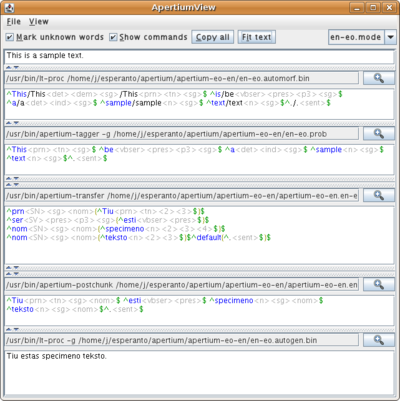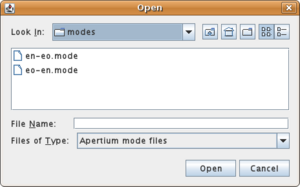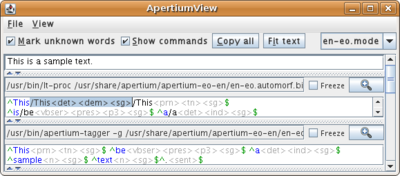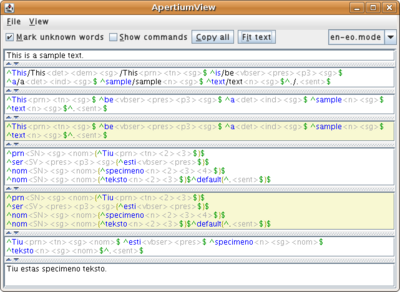Difference between revisions of "Apertium-viewer"
m (Apertium-vju moved to Apertium-viewer) |
|
(No difference)
| |
Revision as of 05:28, 3 October 2008
Apertium-view is a little program which can be used to view and edit the output of the various stages of an apertium translation.
The various stages update while you type, and a change made in any one pane updates the subsequent stages.
Currently, the program is in its early stages and it will take some time before it becomes fully usable. But if you are a developer with some knowledge of Java, you can already dive in.
What you need
- Java JDK 1.6
Getting apertium-view
Executable JAR: http://javabog.dk/filer/ApertiumView.jar
Source code (Netbeans project): http://javabog.dk/filer/ApertiumView.zip
Running apertium-view
Just double-click on ApertiumView.jar
It this don't work, type
java -jar ApertiumView.jar
from the command line
Testing unreleased language pairs from subversion
You don't need to install your language pair anywhere to use it. Just choose File | Load mode and select the mode file from the language pair.
Features
- Allow users to set 'mark unknown words' or not (Alt-M)
- Automatically resizing panes (Fit text button, Alt-I). Stages with unchanged text are automatically collapsed.
- Alt-0 brings focus to the first pane (input), Alt-1 to the second, etc. Alt-9 brings focus to the last (output). It autoscrolls to make the panes fully visible.
- Undo on a per text-pane/stage basis (Ctrl-Z, redo is Ctrl-Y)
- Copy all button puts text for all stages into clipboard (Alt-C)
- Commands can be hidden for clearer view (Alt-S)
- Views can be frozen/paused to not propagate changes
- Syntax highlighting
- If a surface form has an ambigious analysis its shown in red. If you click on an alternative it is selected (basically, between / /) and can be removed it pressing Delete key.
- Removing scrollbars when not wanted.
- Configuration / choosing language pair in the GUI.
- Scroll panes down when they fill with more information.
- Zoom button to get a detached window (particularly input and output windows).
- Remember settings when closed (language pair, input text, size of panes, windows size and position etc).
- It DOESENT use dbus. Rather you can just directly point to a mode file and use it. Therefore language pairs can be tested directly from the SVN source directory, without installing them.
Feature requests/bugs
- Restoring of view sizes after restart is not perfect yet (press Fit to text to fix)
- Shrinking view sizes not perfect yet (press Fit to text a few times to fix)
- Moving chunks as units rather than text.
- foo{ bar } baz { bin } → baz{ bin } foo { bar }
Related software
- Apertium-view is a somewhat simpler version of the same program and coded in Python instead of Java and dequires dbus.
- Apertium-tolk is similar to, but much simpler than Apertium-view. It only has an input window and an output window. Where Apertium-view is aimed at developers, Apertium-tolk is intended to be as user friendly as possible.



